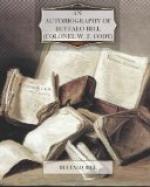Arriving near Tupedo, General Smith selected, as a battleground, the crest of a ridge commanding the position Forrest had taken up. Between the two armies lay a plantation of four or five thousand acres. The next morning Forrest dismounted some four thousand cavalry, and with cavalry and artillery on his left and right advanced upon our position.
Straight across the plantation they came, while Smith rode back and forth behind the long breastworks that protected his men, cautioning them to reserve their fire till it could be made to tell. All our men were fighting with single shotguns. The first shot, in a close action, had to count, or a second one might never be fired.
I had been detailed to follow Smith as he rode to and fro. With an eye to coming out of the battle with a whole skin I had picked out a number of trees, behind which I proposed to drop my horse when the fighting got to close quarters. This was the fashion I had always employed in Indian fighting. As the Confederates got within good range, the order “Fire!” rang out.
At that instant I wheeled my horse behind a big oak tree. Unhappily for me the general was looking directly at me as this maneuver was executed. When we had driven back and defeated Forrest’s men I was ordered to report at General Smith’s tent.
“Young man,” said the General, when I stood before him, “you were recommended to me as an Indian fighter. What were you doing behind that tree!”
“That is the way we have to fight Indians, sir,” I said. “We get behind anything that offers protection.” It was twelve years later that I convinced General Smith that my theory of Indian fighting was pretty correct.
After the consolidation of the regular army, following the war, Smith was sent to the Plains as Colonel of the Seventh Cavalry. This was afterward known as Custer’s regiment, and we engaged in the battle of the Little Big Horn, in which that gallant commander was slain. Smith’s cavalry command was moving southward on an expedition against the Kiowas and Comanches in the Canadian River country, when I joined it as a scout.
Dick Curtis, acting as guide for Smith, had been sent on ahead across the river, while the main command stopped to water their horses. Curtis’s orders were to proceed straight ahead for five miles, where the troops would camp. He was followed immediately by the advance guard, Smith and his staff following on. We had proceeded about three miles when three or four hundred Indians attacked us, jumping out of gullies and ravines, where they had been securely hidden. General Smith at once ordered the orderlies to sound the recall and retreat, intending to fall back quickly on the main command.
He was standing close beside a deep ravine as he gave the order. Knowing that the plan he proposed meant the complete annihilation of our force, I pushed my horse close to him.
“General,” I said, “order your men into the ravine, dismount, and let number fours hold horses. Then you will be able to stand off the Indians. If you try to retreat to the main command you and every man under you will be killed before you have retreated a mile.”




